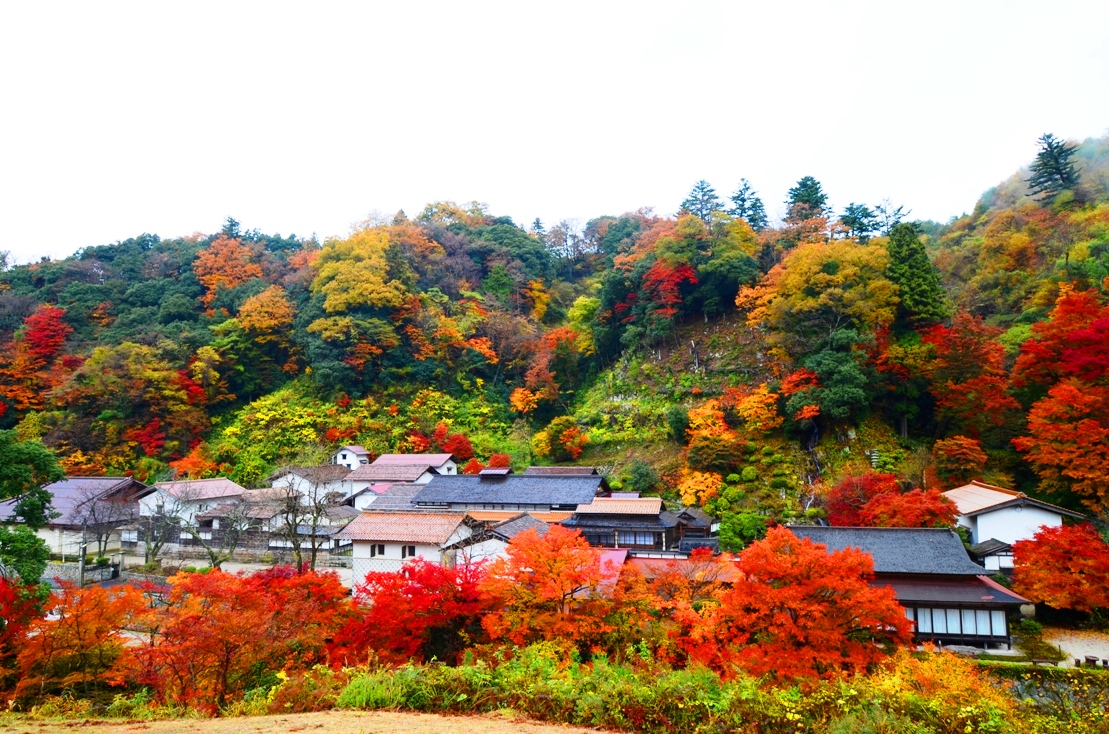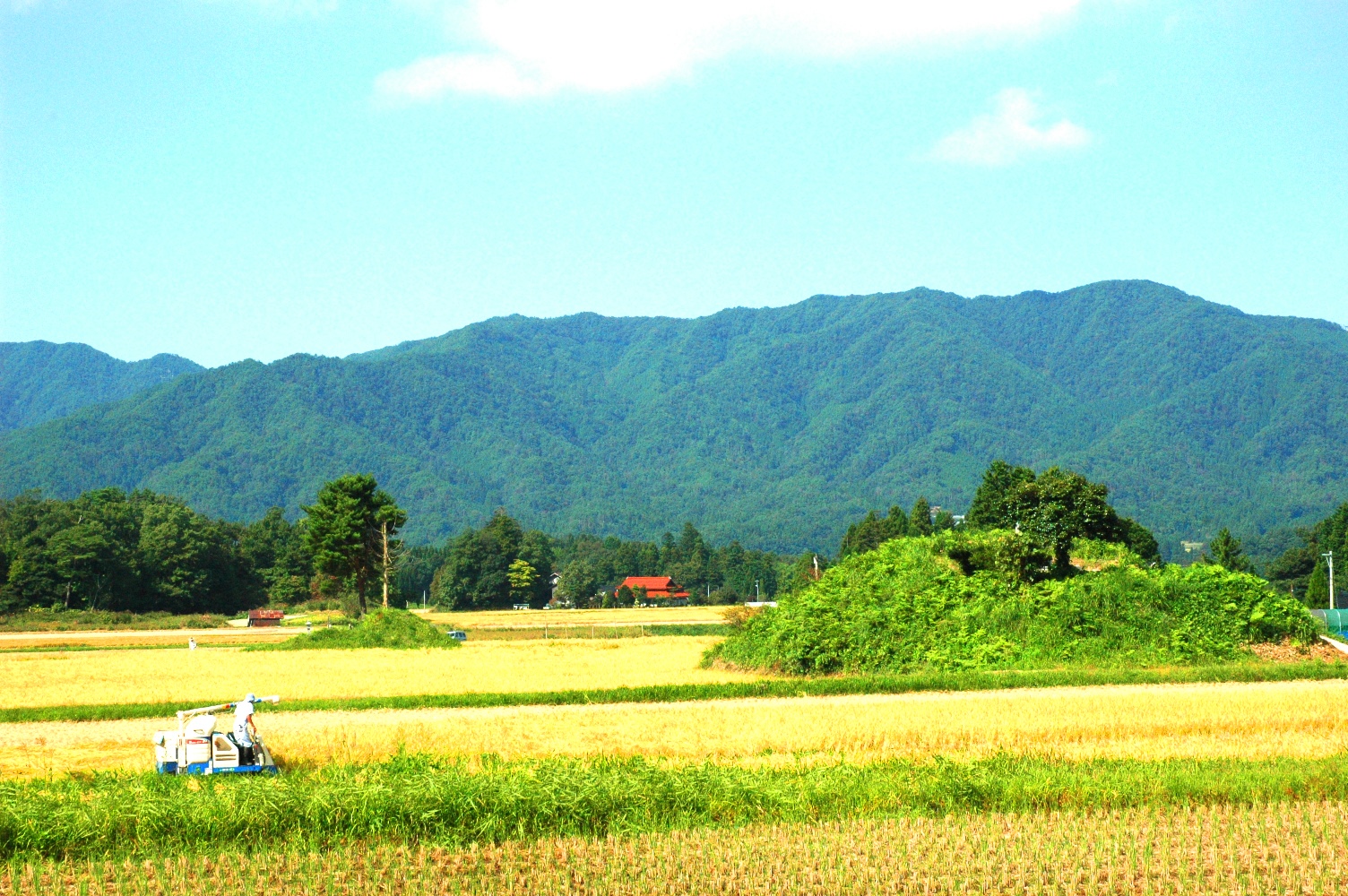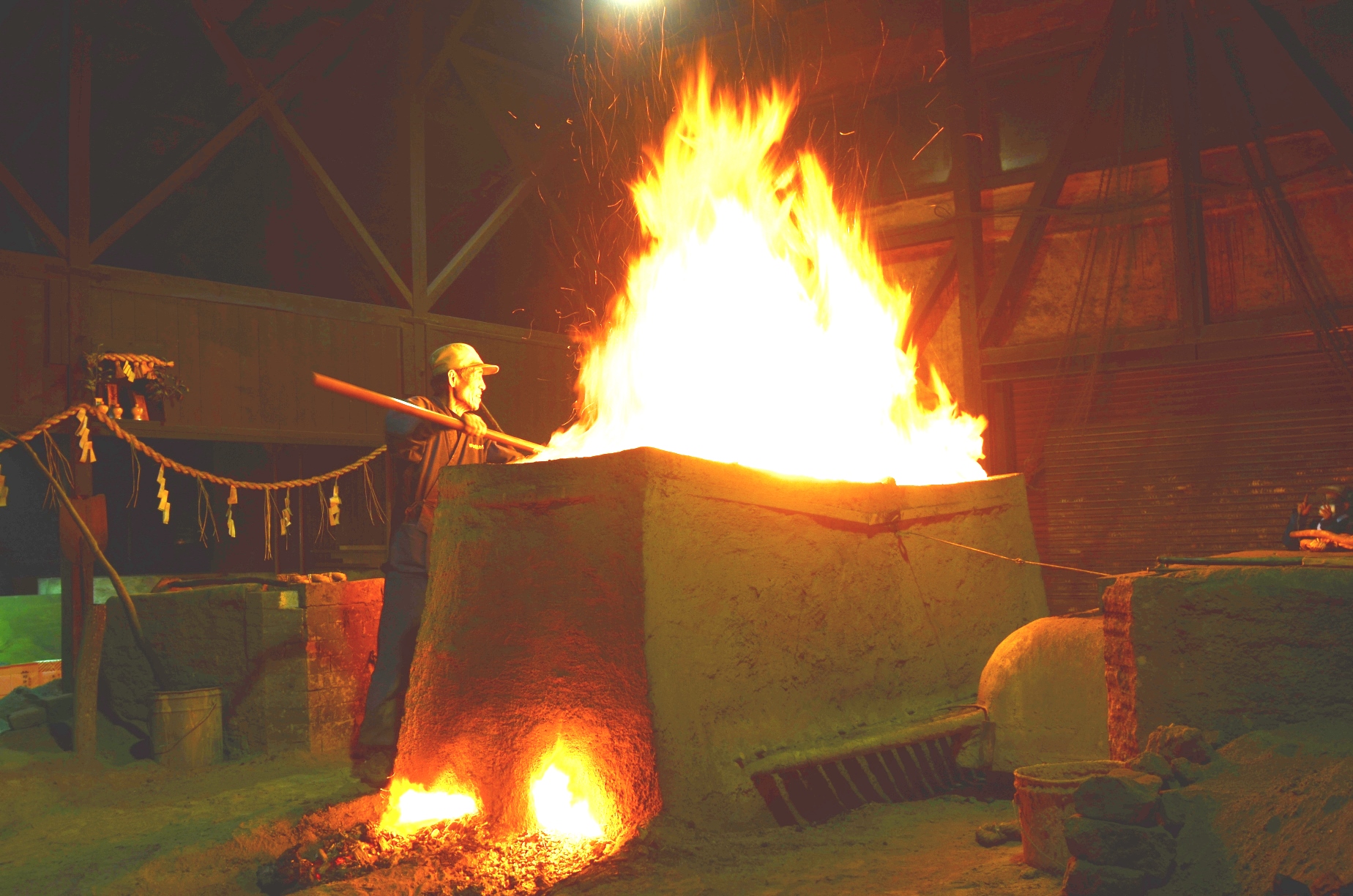Glimpse of Designated important cultural landscapes in Okuizumo
最終更新日:2019年4月1日
たたら製鉄を背景とする重要文化的景観の概要
重要文化的景観申出者 奥出雲町長
Applicant : Okuizumo Town Mayor
重要文化景観の名称 :
奥出雲たたら製鉄及び棚田の文化的景観
The name of Designated Important Cultural Landscapes in Okuizumo
「 Okuizumo Tatara seitetu oyobi Tanada no Bunkateki Keikan 」
Cultural landscapes of Tatara steel making and Terraced paddies in OKuizumo
文化的景観の種類 選定基準2 以下の複合景観地
The selection of Cultural landscape
Selection Criteria2 combination of two or more cultural landscapes as follows
(1)水田・畑地などの農耕に関する景観地
Associated with agriculture such as rice paddies, farmland,etc
(2)用材林・防災林などの森林の利用に関する景観地
Associated with forest use such as timber forests ,disaster prevention forests,etc
(5)ため池・水路・港などの水の利用に関する景観地
Associated with reservoirs,waterways,harbors,etc
(6)鉱山・採石場・工場群などの採掘・製造に関する景観地
Associated with mining or industrial manufacture such as mines , quarries, groups of workshops , etc
(8)垣根・屋敷林などの居住に関する景観地
"Associated with residences and settlements such as stone walls hedges,coppices attached to premises
according to the order of Education Scientific Ministry
文化的景観の所在地及び面積
所在地:島根県仁多郡奥出雲町上阿井、同竹崎、同大呂、同中村、同大谷 同大馬木の各一部
Important Cutural landscapes Designated Places:
Part of Kamiai ,Takesaki, 00ro ,Nakamura ,OOtani, these 7 villages in Okuizumo Town , Nitagun , Shimane Prefecture.
面積:1,563.3ha
Important Cultural Landscapes Designated Total Area: 1,563.3ha
(注)「竹崎」の「崎」の字は、「大」の部分が「立」です。
経緯と経過
Procedure and Process of Application
【平成22年度】
Heisei 22 years( 2010 )
- 町政座談会において各自治会から奥出雲町の有力鉄師であったト蔵家の調査研究やたたら関連遺跡の整備、鉄穴残丘が残る地域について保存・活用を検討するよう意見がだされた。
At the town meeting held by the town office in Yokota, opinions to investigate the Tatara master Bokura family’s history and relics for utilization and preservation were proposed by the residents. - これに対して、本町のたたら製鉄の価値について総合的に再評価・検証するためのプレ調査を実施することになった。この調査により、町内に所在する製鉄遺構をはじめ、たたら製鉄所産の文化遺産を洗い出し、文化財保護法に規定する文化的景観の定義により広範囲におよぶ、たたら製鉄の文化遺産の再評価を行った。
Okuizumo town office began an investigation for revaluing and reaffirming the Tatara steel making according to the basic standard criteria of the Law for the Protection of Cultural Properties. Town office revalued Tatara heritage and properties. - 文化的景観の保存活動の取組として、近年高まりを見せる町民の景観保全意識から、奥出雲町は平成22年10月1日付けにて景観行政団体に移行した。
Under the Landscape Law, the whole Okuizumo town area was named as the landscape district by the Shimane prefectural government in Heisei 22 years (2010)
【平成23年度】
Heisei 23years
- 奥出雲町景観計画の策定(平成24年4月1日、奥出雲町景観条例が施行)をした。
Under the Landscapes Law , "the ordinace of Okuizumo Town landscape" was approved by town assembly in Heisei 24 years(2012).
Okuizumo Town landscape's Conservation Planning was established. - たたら製鉄を背景とする文化的景観の価値について、奥出雲町文化的景観調査検討委員会を設置し、学術調査を行い、『奥出雲町文化的景観調査報告書』をまとめた。(平成23年度~24年度の2か年)
The committee ,it consisted of 10 members for surveying the value and component of cultural landscapes in Okuizumo ,they compiled the report of the survey for cultural landscapeing in Okuizumo (in Heisei 23 ~24years ).
【平成24年度】
Heisei 24years
- 選定申出地域に係る重要文化的景観区域の保存管理に関わる『奥出雲町文化的景観保存計画』を策定した。
The Cultural Landscapes Preservaton Plan , concerning the proposed 7 area, was established. - 重要文化的景観の申出範囲の対象住民に対して合意形成(同意書)を実施した。
Getting the contents from the residents who were associated with the application.
【平成25年度】
Heisei 25years
- 重要文化的景観の申出に必要な関係書類を整え、平成25年7月に文部科学大臣あて、申出書を提出した。
Final application forms for Designation Important Cultural Landscapes in Okuizumo was submitted to the Ministry of Education(MEXT) in July Heisei 25years.
文化的景観の保存状況
Preservation of Cultural landscapes in Okuizumo
天平5年(733)に編纂された『出雲国風土記』の仁多郡(現在の奥出雲町にあたる)の条に三所(みところ)郷(のさと)・布勢(ふせの)郷(さと)・三沢(みざわの)郷(さと)・横(よこ)田(たの)郷(さと)あわせて4郷が所在し、「諸郷(もろもろのさと)より出(いだ)すところの鉄(まがね)堅(かた)くして、尤(もっと)も雑(くさぐさ)の具(もの)を造(つく)るに堪(た)ふ」と記している。
“Izumo no kuni Fudoki” , Province records compilation was ordered by Empress Genmei in 713 , completed in Ten-pyou 5 years (in 733 ) wrote “ Steel products in Mitokoro, Fuse ,Mizawa and Yokota villages were good enough to make any iron goods”at Nita/Okuizumo chapter .
このことは、その当時から盛んに製鉄が行なわれていたことを示すとともに、当地方で産する鉄の優秀性を物語っている。
そして、今日もなお世界で唯一“たたら製鉄”の炎があがる町として全国に周知され、その技術は国選定保存技術に選定されている。
This description indicates that steel production had been prosperous and had produced highest quality of steel since ancient times in Okuizumo .
Okuizumo is the only place in the world that the Tatara craft is designated as Conservation Techniques for Cultural Properties under the Law. It is still in operation now at Ni-tto-ho Tatara furanace in Torikami village.
歴史的に見ると、近世・近代にかけて奥出雲地域は、我が国の鉄生産の中心地として隆盛を極め、たたら製鉄で栄えた地である。
From a historical point of view, Okuizumo area has been a central place for steel making in Japan and has had Steelmaking Tatara techniques handed down for many generations.
また、松江藩の鉄政策により、櫻井(さくらい)家、絲(いと)原(はら)家、ト蔵(ぼくら)家という大鉄師(だいてつし)(たたら経営者)を産みだし、櫻井家住宅は国重要文化財に指定され、絲原家住宅は登録有形文化財に登録されるなど、鉄師頭取の佇まいを今に残している。
In the Edo era, Matue han/the Matue domain (associated with Izumo province ) by its new restriction policy , admitted only 10 Tatara owners (enterprisers) including the Sakurai family , Itohara family , Bokura family in Okuizumo to manage Tatara steel making.
Nowadays Sakurai houses are designated as Important Cultural Properties of Japan . Itohara houses are selected as Registered Tangible Cultural properties.
Those houses serve as a remainder of the livelihood of the old age “Tessi- todori”, Head of Tatara ownwrs union in Matue han .

中国山地脊梁部は、地質的に良質な砂鉄(磁鉄鉱)を多く含有する地帯であることから、丘陵を切り崩し水流によって比重選鉱するという「鉄(か)穴流(んななが)し」が広範囲に稼業された。この鉱山跡地(鉄(か)穴流(んななが)し跡)は豊かな棚田に拓かれ、今日において、生産米は「奥出雲仁多米ブランド」となっている。
また、山林は、たたら製鉄用の燃料木炭林として旺盛に製炭活動がなされたが、永続的に循環できるよう約30年周期で輪伐しながら保全してきた。
The Chugoku mountain north-face ranges that contain high quality magnetite iron sand, the way of gatheing iron sand called “ Kanna - nagashi“, screening collection by flowing water, by which iron sands sank to the bottom of the waterway and were easily collected .
Due to the way of Kanna- nagashi, the eroded mountain area was converted to terraced rice fields where the good taste of Okuizumo Nita rice was cultivated.
It is well known as an expensive , high quality brand of rice in Japan.
Furthermore , the trees that had grown up in the forests and were burned to charcoal for Tatara fuel were cut in a 30 year cycle in order to avoid destroying the forest’s regrowing cycle .
このように、本町の文化的景観はたたら製鉄の歴史とともに形成されてきたものであると同時に環境共生・循環型であり、世界に類のない鉱山跡地に形成されたものである。そして、鉄(かん)穴(な)横手(よこて)(水路)や特異な鉄穴残丘が点在する棚田が広がりをみせる農山村集落の背景に、かつて鉄山(てつざん)(たたら製鉄用の木炭山林)であった山々が取り囲むという特色ある文化的景観を形成してきた。
As for the cultural landscapes in Okuizumo , they were the kind of landscapes which evolved together with Tatara steel making history and with the recycling process for the natural features of a moutain mine .
“Kanna - yokote” ,a water way dug around the base of a moutain , and “ Kanna zan-kyu” ,left over mounds in the fields, are scattered throughout the paddy fields.
They represents specific features and creates special views of these important cultural landscapes in Okuizumo .
今日の文化的景観を見ると、鉄穴流しのために導かれた鉄穴横手(水路)は、現在も農業用の潅漑用水路として引き続き使われており、基本構造はそのまま踏襲されている。また、墓地や鎮守の杜が所在したことにより流さず残された丘陵部分は「鉄穴残(かんなざん)丘(きゅう)」として良好に保存されるなど、たたら製鉄を背景とする文化的景観が保存継承されている。
With regards to cultural landscapes in Okuizumo today , Kanna- Yokote water ways are used as rice crop water ways as well .
The basic function from the old days has been preserved.
Graves and shrine forests preserved as hill places of Kanna- zankyuu created by “kan na - nagashi” have been kept in good condition , too.

地域住民は、自治組織での道路愛護活動、環境美化活動はもとより、先人から受け継いだ歴史的建造物の維持管理や伝統行事も鋭意継続している。
また、全国的な広がりを見せる耕作放棄地も少なく、営農意欲は旺盛で、棚田の維持管理が行われている。
Residential neighborhood units continue not only to serve as road repairing and beautifying village surroundings, but also keep traditional rituals ,festivities, house management and so on.
With this cooperation there are few abandoned paddy fields here in comparison to other places around Japan.
さらに、学校教育においては、たたら製鉄を総合的に学習するプログラムがつくられつつあり、「たたら・炭焼き・鉄穴流し」の実体験活動やフィールド学習(文化的景観)から本町の歴史文化を知り、郷土を愛する心が育まれている。
これらが、結果的に文化的景観を保存することにもつながっており、保存継承の環境が整ってきている。
Moreover, in Okuizumo town all 9 elementary schools hold Tatara studying curriculum for 5th grade pupils.
They experience charcoal making, kanna-nagashi, and smelting iron sand into steel in the special small scale Tatara furnace .
For these elementary school chidren ,field studying deepens their knowledge about Tatara and grows their loves for their homeland’s culture and history.
以上、今日まで良好な状態で保存されてきた文化的景観は、これまでの景観形成過程で同時につくられた地域の伝統とルール(慣習)によって守られてきたものであるといえる。
The above mentioned deeds have kept cultural landscapes preserved in good condition as well as Okuizumo resident’s traditions and customs .
文化的景観の特性(たたら製鉄を背景とする文化的景観)
Special features in Okuizumo Cultural landscapes (Background)
奥出雲町は島根県の東南端に位置し、鳥取県と広島県との県境にあたり、中国山地脊梁部の中央、山懐に抱かれた山間地域である。
このため豊かな自然が残り、取り囲む山々は、四季折々の彩りを見せる。
Okuizumo town is located south-east in Shimane prefecture and situated on borders between Hiroshima prefecture and Tottori prefecture, facing the north side of the Chugoku mountains .
In Okuizumo, the beauty of nature has been preserved since ancient times with the surrounding mountains changing their colors throughout the four seasons.
また、歴史的にみると風土記時代から連綿と砂鉄をとり、炭を焼いて、たたら製鉄を行なってきた地である。
そして、近世から近代初頭まで、我が国の一大生産地帯として隆盛を極めた。
この間、中国山地より派生するなだらかな山麓丘陵地が、砂鉄採取のために稼業された「鉄(か)穴流(んななが)し」により切り崩し流され、本町の地形変貌に与えた影響は多大である。
This has been the Tatara steel making place as well as the gathering place for its materials, such as gathering iron sand and burning wood into charcoal, since the ancient Fudoki period .
Especially from the Edo period to the Meiji era, the Okuizumo area had occupied the main role of steel making in Japan .
In these terms , Okuizumo’s topographical features owe much to the way of gathering iron sand, called Kanna- nagashi.
It had cut into the mountains deeply, changing the whole landscape .
一方、中国山地の尾根に広がる豊富な山林資源は、たたら製鉄が永続操業できるよう、約30年周期で輪伐することにより保全管理されてきた。
林野に分け入ると無数の炭窯跡が残り往時の製炭風景を偲ぶことができる。
On the other hand , Tatara fuel charcoals made from forest wood spreading throughout the back of the Chugoku mountains , have been cut with a 30 years regrowing cycles.
Whenever we go into the mountains ,we can see and find charcoal clamp relics scattered around .
本町の基幹産業は農業であり、この農業基盤をつくりだしたのが鉄穴流しである。
奥出雲町横田地域の3分の1以上が鉄穴流しを起源とする棚田である。
これには、流し込み水田等の判断が難しいものは除外されており、このことを踏まえて考えると、本町の農業基盤は鉄穴流しに負うところが極めて大きいといえる。
The main industry in Okuizumo has been agriculture.
This land reclaiming process depends on the Tatara way of kanna-nagashi. It is kanna-nagasi that contributed to the development of agricultural farm lands .
About one third more terracial paddies in Yokota, Okuizumo would have been created by kannna-nagashi .
This rate does not include the way of reclaiming the paddy fields uncertain .
From this viewpoint, we can say that almost all farm land had been created by kanna-nagashi.
このように、本町の文化的景観特性は、当地方の豊かな山林資源と地質的に風化花崗岩地帯であったという恵まれた自然環境のなかで、たたら製鉄という歴史的背景により拓かれた棚田が広がりを見せる景観構造となっている。
The specifics of cultural landscapes in Okuizumo , terracial paddy fields formed by kanna-nagashi, historically depend on Tatara .
Furthermore , the natural features of rich mountain woods as well as the geological feature of weathering granites containing iron sand, had been used as Tatara materials.
ここに、鉄師(てつし)頭取(とうどり)の佇まいや山内(さんない)(鈩場及び労働者住居が一体となった区域)、登録有形文化財鳥上木炭銑工場などの遺構、鉄穴流しで拓かれた棚田及び農山集落が有機的に結びつき、景観を形成している。
Here , cultural landscapes consist of Tatara steel master ,Tessi to- dori, living house and furanace factory,
they are designated and registered national properties , and workers condominiums , called San-nai .
Furthermore, the relics of Torikami charcoal pig-iron making factory,Torikami mokutan zuku kou-jyou, are named as a registered national property.
奥出雲の自然環境とたたら製鉄
Natural Features in Okuizumo and Tatara Steel Making
本町の東部、中国山地から北に向かって分岐する支脈に船通山(せんつうざん)がある。
この山が古事記・日本書紀に登場するスサノオノミコトのヤマタノオロチ退治神話の舞台となった地であり、出雲神話発祥の地とも語られている。
ここを源流とする一級河川の斐伊川(ひいかわ)が渓谷の細流を取り込みながら、東西に向かって流れ下っている。
Mountain Sentu remains the northern dividing place of the main Chugoku mountain ranges , which run through the center of Chugokuku districts .
It was well-known as a mythological battle place “Yamata- no- orochi taiji”, 8-headed big snake conquest story, written in mytho-historical documents, the Nihon-shoki and the Kojiki .
The god “ Susano” conquered “Yamata no orochi” an 8- head serpant by intoxicating it with sake.
After killing Yamata-no- orochi he found the holy sword “Ame no murakumo no Tsurugi” in snake’s tail which was dedicated to the God “Amaterasu”and later became one of the three regalia of the imperial household .
This mythological Hii river, originates from here, Mt. Sentu, and flows east converging many streams .
地質的に見ると、奥出雲町の母岩の大部分が、深層風化が進んだ花崗岩地帯に属し、この母岩にチタンなどの不純物が少ない良質な砂鉄(磁鉄鉱)を含有し、良鉄を得られることから、この地帯が広範にわたり鉄穴流しで流された。
また、山々の豊富な山林資源が、燃料となる薪炭林になるという恵まれた自然環境であった。
According to the geological point of view , most mother rocks in the mountains here have vast granite layers which contain pure iron sand with little unpure materials ,such as chitan, etc.
The gathering of iron sand through kan na nagashi has been done for a long times and massive abundant forest wood was used to make charcoals for Tatara fuel.
以上のように、本町の恵まれた自然環境がたたら製鉄の原料(砂鉄)と燃料(木炭)の供給の両面で有利に働き、たたら製鉄の一大生産地帯になった大きな要因といえる。
The surrounding mountains supply of not only rich natural resources of iron sand but also charcoal have contributed to Tatara steel smelting’s useful role of being a great production place in Japan.
たたら製鉄の歴史と奥出雲
Tatara Steel making History and Okuizumo
出雲国風土記(733)の仁多郡の条に本地域で産する鉄の優秀性が語られた背景として、既述のとおり恵まれた自然環境があったことにより、注目され発展していった。
戦国時代には、毛利氏が良鉄の産地として目を付け、鉄奉行を送り込み直轄支配して鉄の確保を図っている。
Nita district’s high quality of steel in Izumo no kuni Fudoki owes much to natural environments here in Okuizumo .
During the Sengoku battle period(1467~1603),the controller of the Chugoku region Daimyo Mori clan appointed a special administrator here for the rule of steel production.
江戸時代初頭、堀尾氏は広瀬の富田城から城を松江に遷した。この松江城は、本町を源流とする斐伊川の最下流に位置することから、鉄穴流しで流される土砂が要害に障りがあるとして慶長15年(1611)に鉄穴流しを禁止した。
All the beginning of the Edo period(1603 ~1868), the Matsue Daimyo Horio Clan moved their headquarter castle from Hirose to Matsue.
Here, the Hii river flows into Lake Shinji .
Horio prohibited Kanna- nagashi in Kei-cho 15years( 1611 ) for the purpose of preventing flooding.
The main reason for the flood was the Hii River’s raised floor height by kanna- nagashi sand’s accumulation.
鉄師からの度重なる嘆願にも叶わなかったが、堀尾氏にかわって入封してきた京極氏が、寛永13年(1636)にようやく鉄穴流しを解禁した。
これにより、仁多郡内において十数か所の鈩が吹きたてられて活況した。
Despite the begging by steel production enterpriser “Tessi” union , Horio did not permit the Kanna- nagashi at all.
Daimyo Kyougoku Clan who appointed by Tokugawa Shogun as a successor , permitted it finally.
Kyougoku permitted Kan na nagasi in Kan-ei 13years (1636), stopping after 25 years . By restarting kanna- nagashi, about ten Tatara furnaces arose in here Okuizumo .
The steel smelting fire flame was seen vividly.
また、享保11年(1726)に松江藩は出雲鉄方御法式を布いて、絲原家、櫻井家、卜蔵家、田部家等の有力鉄師(たたら経営者)のみ鈩株(鈩経営権)を与え、たたら場10か所のみに制限して、たたらの安定経営をはかった。
Kyouho 11years ( 1726 ), Matsue han (domain) Daimyo Matsudaira issued an edict, “Tetsu kata go houshiki”,the rule of steel making , and gave the privilege of making Tatara steel to only 10 Tatara masters , enterprisers, such as Itohara family, Sakurai family Bokura family in Okuizumo , and Tanabe family in Unnan .
The limiting of 10 owners to Tatara furnace construction was due to the stable steel supply and production, policy .
しかし、たたら製鉄は明治時代中期以降、洋式近代高炉の操業や安い洋鉄に圧されて衰退を余儀なくされ、大正末年をもってたたら製鉄の炎が消えた。
However Tatara steel production had declined because of mass production techniques and cheaper imported steel pressure during the middle Meiji period.
As a result , Tatara steel smelting extinguished its fire at the end of the Taisho era , in 1924.
たたら製鉄の衰退とともに、小花冬吉博士が広島県落合製鉄所にて考案した小高炉の角型炉が各地に建設された。
鳥上(とりかみ)地区に所在する鳥上木炭銑工場の角型熔鉱炉(国登録有形文化財)は、全国最後となる昭和40年9月までその炎を燃やし続けた。
The declining of old style Tatara gave way to a mass production industry.
Metallurgist Obana Fuyukichi invented “ Kakuro”, High Square Furnace , in Hiroshima and constructed it many places in Japan.
It used materials of iron sand and coal capable of two or three times productivity compared to the traditional Tatara furnace.
This type of Kakuro, used lateset until Shouwa 40 years (1960) in Torikami village , this Square Furnace was named a registered national property in Heisei 9years (1997) .
また、軍刀の原材料である「玉鋼(たまはがね)」は、唯一たたら製鉄のみでしか得られず、その需要に応えるため「靖国鈩」が昭和8年に建設され、終戦まで操業した。
終戦によりまたもやたたらの炎が消え、いよいよ「玉鋼」が枯渇したことから、昭和52年11月に公益財団法人日本美術刀剣保存協会の努力によって再びたたら製鉄の炎があがった。
In the Shouwa period , 1926 to 1689, especially during the World War 【2】, 1931 to 1945 , there had been such strong demands for military swords that the association “ Nihontou - Touren -kai “ was built in Shouwa 8 years (1933) supported by the Military Ministry.
Japanese swords had been made only by using “Tamahagane “ materials produced by Tatara smelting skills , so Nihontou- tanren- kai had Yasukuni Tatara built in Shouwa 8 years(1933).
It remodeled the steel master Bokura’s furanace in Torikami village , which had been operated until the end of the war (1945), when it closed its operation.
Concerning the Japanese sword , after ceased operations of Tatara brought about a lack of Tamahagane.
In Shouwa 53 years (1977), the Society for preservation of Japanese Swords , Nihon-bijyututou- toren- kai(Nittou-ho) , with the support of the government’s Agency for Cultural Affairs, rebuilt the Nitto- ho Tatara furnace into operation, in response to the scarcity of Tamahagane material for Japanese swords.

このように、たたら製鉄とともに歴史を刻んだ本町は、たたら製鉄に関連する歴史的建造物や遺構、鉄穴流し跡に拓かれた棚田など、たたら製鉄を背景とする独特な文化的景観が形成されてきた。
In this way Okuizumo Town has progressed with Tatara steel making , so that historical buildings , relics and terracial paddies reclaimed by kanna-nagashi, all associated with Tatara , have created special cultural landscapes in Okuizumo.
たたら製鉄がもたらした「奥出雲仁多米」
Okuizumo Nita Rice Nourished by Tatara Kanna-nagashi
かつて世界最大の砂鉄鉱山であったとされる中国山地の山麓丘陵地は、鉄穴流しによる地形変貌の痕跡を顕著に示し、特に奥出雲町は濃密に鉄穴流しが稼業されたことが知られている。
Chougoku mountain mines abundant in ironsands were well known for the topographical change brought by the Tatara kannna- nagashi . Especially in the Okuizumo Town area , its historical relics were left here and there.
世界的に見ると、鉱山跡地は採掘が終わると投棄状態となり荒廃するのが通例である。
このため、鉄穴流しによる地形環境変貌も、一見すると環境破壊と捉えられる。
しかしながら、鉄穴流しの跡地は放置されることなく、鉄穴流しの用水を導いた「鉄(かん)穴(な)横手(よこて)」やため池をそのまま活用し、豊潤な棚田を造成していった。
Concerning mining in the world in general, closing mines had left bad effects such as erosion ,contamination , and unworthy land use .However , the kanna- nagashi way had changed land into worthy rice crop fields .
Furthermore , Kanna - yokote , which was used well as a waterway and reservoir ponds in the old days , has continued its use today , just as it was before.
本町横田地域にあっては、田畑面積1,639haに占める鉄穴流しによる地形改変によって拓かれた農地は535haであり、実に32.6%に及ぶものである。
これは、判断が困難な流し込み水田等を除いた数値であり、これを含めて考えるならば、本町の農業基盤は鉄穴流しに負うところが極めて大きいと指摘されている。
Yokota area’s paddy fields are 1,639 square ha , of which about one third (32.6%) 535 ha of the fields were reclaimed by the kannna- nagashi.
These rates do not include the fields of which reclaiming way was uncertain.
So including these places it is not too much to say that Okuizumo town’s fundamental agricultural fields had been formed by the Tatara Kanna- nagashi .
このように、本町の砂鉄鉱山跡地に拓かれた棚田は、我が国の文化、気候風土により育まれた環境共生、自然循環というシステムが構築されてきたもので、世界に類のない鉱山跡地に拓かれた文化的景観であるといえる。
These terraced paddy fields in Okuizumo reclaimed after iron sand digging, were not to be seen in the world .
These have been cultivated and nourished by natural Japanese environmental elements and climates.
These cultural historical aspects not only show a recycling natural process but also the cooperation of natural elements .
そして、一帯にたたら製鉄関連の遺構が残り、「鉄穴横手(水路)」や墓地等が所在したために残された「鉄穴残丘」などが点在し、かつて鉄山(たたら製鉄用木炭山林)であった山々を背景に広大な棚田が広がるという、たたら製鉄で形成された文化的景観そのものが今日の生業になり、たたら製鉄が奥出雲の大地に息づいている。
Now , kanna- zankyuu , left mounds , which were the historical relics of the kanna -nagashi ironsand gathering way , were left to prevent eroding : such as graves and kanna- yokote ,water way, were scattered around the foot of the mountains and in the fields.
This extending scenery with a mountainous background reminds us of the prosperous old times of Tatara mining .
It breathes by reflecting the Tatara livelihood of old times into the important cultural landscapes of today.
このページを見た方はこんなページも見ています
お問い合わせ
役場 教育魅力課
電話番号:0854-52-2672
FAX番号:0854-52-3048
